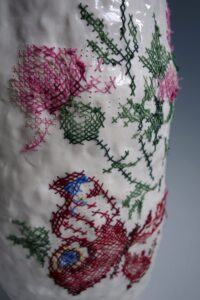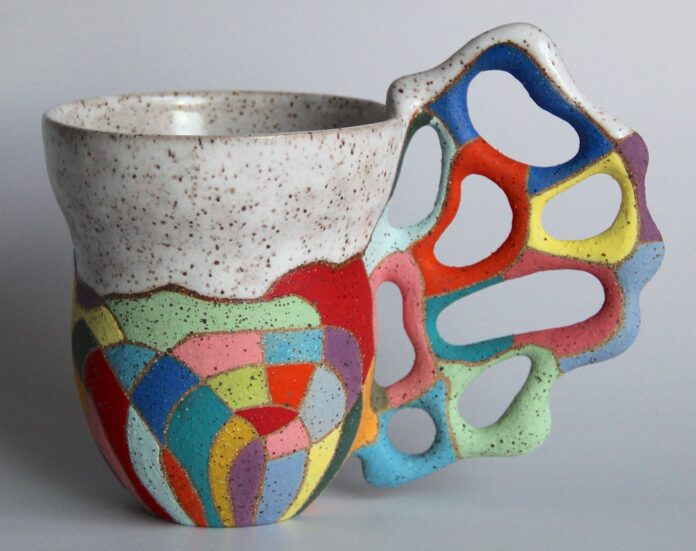“Interwoven Narratives: The Artistic Alchemy of Caroline Harrius’s Cross-Stitched Porcelain and the Future of Smart Textiles”
Greetings, fellow textile aficionados! Textile Topher here, with a captivating journey that marries the antiquity of cross-stitch embroidery with the modern allure of porcelain art. If you haven’t yet stumbled upon Caroline Harrius’s avant-garde creations, prepare to be thoroughly enchanted. Her vases aren’t merely functional pieces; they are profound statements exploring the convergence of craft, history, and gender roles. Buckle up as I unravel the beauty and significance behind these magnificent porcelain vases.
The Union of Two Worlds
Caroline Harrius, a Stockholm-based artist, has masterfully intertwined two historically rich crafts: cross-stitch embroidery and porcelain vase creation. Imagine delicate, ready-made cross-stitch patterns or Harrius’s own floral motifs meticulously embroidered directly into tall, porcelain vases. It’s a marriage of textures and techniques, ages and purposes, domesticity and artistry. Small holes are judiciously studded into the porcelain just wide enough to allow the thread to pass through, creating a semi-functional vase that stands as a testimony to the long-standing interplay between decoration and utility.

Craft and Concept
Graduating with an advanced degree in ceramic art from Konstfack University, Harrius began this intriguing series with a sense of discomfort. Her initial embarrassment, almost a sign of eschewing traditional norms, dissolved as she embraced the unique value her works carried. She notes how she initially felt “ashamed” of these curvilinear vases, an emotion that intriguingly speaks to societal expectations and the artist’s emotional journey in challenging such constructs. By placing cross-stitch embroidery—a craft often associated with domestic leisure and women’s work—onto sturdy, elegant porcelain, Harrius accentuates the often underappreciated blend of beauty and purpose that crafts provide.
This interplay invites us to consider broader cultural narratives. Historically, textiles like embroidery and cross-stitch have been relegated to ‘women’s work,’ a categorization that often undermined their artistic worth. By pulling such techniques into the sphere of fine art and combining them with porcelain—a material often associated with high craftsmanship and value—Harrius effectively reclaims and recontextualizes these crafts.
The Revolutionary Crafts: Smart Textiles
Speaking of intersections, let’s delve into a contemporary counterpart: smart textiles. For the uninitiated, smart textiles, or e-textiles, are fabrics integrated with digital components like batteries, lights, and electronics. This revolutionary blending allows textiles to interact with the environment or user, respond to stimuli, or even provide functionalities beyond mere aesthetics. Imagine your attire responding to your body temperature or changing color with the push of a button!
Smart textiles often incorporate conductive threads—materials that conduct electricity, such as silver-coated nylon or threads infused with carbon nanotubes. These threads can be intricately woven or embroidered into fabrics to create circuits, akin to Harrius’s precise needlework in porcelain. Conductive threads are vital in the production of smart clothing, offering endless possibilities, from health-monitoring attire that checks vital signs to garments with embedded LED lights that can change patterns.
Technical Textiles in Practice
Let’s pivot to another fascinating development: technical textiles, a sector dedicated to high-performance fabrics. Unlike traditional textiles, technical textiles are engineered for specific functions, often for non-decorative purposes. They find applications in industries like aerospace, automotive, medical, and environmental sciences.
One compelling example is geotextiles. These are permeable fabrics used to improve soil characteristics. They are predominantly used in civil engineering, helping to stabilize terrain, manage erosion, or aid in drainage. These textiles have to adhere to strict performance criteria, such as tensile strength, abrasion resistance, and adaptability to environmental conditions, much like the criteria governing the robustness and aesthetic resilience of Harrius’s porcelain vases.
Studio Space: A Ground of Discovery
Harrius’s creative sanctuary, now the iconic Gustavsberg porcelain factory in Sweden, is brimming with history and inspiration. This iconic institution has been a hotbed for ceramic innovation since the late 19th century. Working in such a rich historical environment undoubtedly influences one’s output. The ambiance here offers Harrius both the physical resources and the cultural backdrop to push the conceptual boundaries of her craft.
Beyond Flora and Porcelain
Harrius’s exploration is not limited to the floral. As she gears up to create a third piece embellished with black-and-white stitching, we’re collectively taken along a narrative that contrasts traditional floral themes with modern, monochrome aesthetics. This piece, still in its conceptual stage, promises to challenge yet another aspect of historical craft techniques and how we perceive and value them today.
Unraveling Cultural Narratives
The juxtaposition of traditional cross-stitch and modern porcelain by Harrius compels us to reassess cultural narratives surrounding women’s crafts and male-dominated industries like porcelain making. By elevating a traditionally domestic craft to the echelon of fine art, Harrius not only questions gender roles but also demonstrates how art can transcend its utilitarian origins to evoke deeper societal dialogues.
Embroidery on Porcelain: An Artistic Alchemy
Embarking on a more granular level, the techniques Caroline employs could be likened to an artistic alchemy. The skill needed to etch precise, tiny holes into porcelain without compromising its structural integrity is no mean feat. Porcelain itself is a notoriously challenging medium—its firing process requiring exact temperatures and conditions. Combine this with the intricate precision demanded by cross-stitch embroidery, and you have an artwork that is as much a technical marvel as it is a visual delight.
Final Thoughts: An Ode to Multifaceted Craft
The burling synergy of cross-stitch and porcelain in Caroline Harrius’s work isn’t just a feast for the eyes; it’s a profound commentary on the intersection of gender, craft, and history. Her vases encapsulate not just flowers, but the essence of a cross-disciplinary dialogue that urges us to rethink the value of traditional crafts in a modern world.
As we stand on the cusp of technological innovations in smart and technical textiles, Harrius’s techniques act as an anchor, reminding us of the timeless beauty and inherent value of handcrafts. The future of textiles may be replete with sensors and conductive threads, but the soul of the craft lies in the meticulous, loving handiwork reminiscent of Harrius’s embroidered vases.
Stay curious, my fellow textile enthusiasts, and keep weaving your own stories, whether through the loom, the needle, or the circuit. Keep an eye on Harrius’s work for an ongoing dialogue between the age-old and the avant-garde. Trust me, the best is always yet to come. Until next time, this is Textile Topher, signing off with threads of wonderment.
Keywords: Caroline Harrius, Cross-stitch embroidery, Porcelain vases, (Post number: 108), Smart textiles, Gender roles





